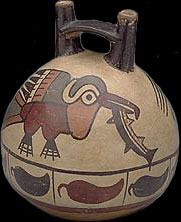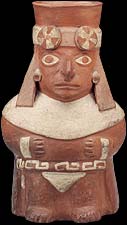
|
![]()
Another lively ceramic in the exhibition is the Mayan vase. Ceramics was just one of the many art forms in which the Maya excelled; they also created exquisite sculptures, monumental architecture, delicate jewelry, and fabulous textiles. This colorful vessel depicts a scene from their epic tale, the Popul Vuh, in which the twin heroes are transformed into monkeys. One monkey holds a cacao pod, source of the beans used in making chocolate, as highly appreciated among the historic Maya as it is today.
The cultures of Central America also prized gold. Unusually high-quality gold existed naturally in local streambeds, and native artists created intricate and sophisticated gold jewelry for members of the higher ranks of society. Animal imagery was common; monkeys were associated with warriors and strength. The pendant in this exhibition would have been worn by a nobleman or ruler to emphasize his warlike abilities and probably also to designate his membership in the Monkey Clan, one of only two groups whose men were eligible to become chiefs.
Another object with a powerful symbolic message is the flying panel metate, which came to our collection from Harold and Rada Fredrikson. Metates were everyday objects that provided a grinding surface for grain, but this one is exceptional, as its size and detailed carving show it to be a prestigious object belonging to a ruler. Overall, through the combination of its function and its complex human and animal imagery, this large and intricately sculpted grinding stone communicates essential ideas about the role of the chief as protector of and provider for his people.
Prosperity frees a society to produce all forms of art, a situation true among the great civilizations of Peru. A wealth of art, encompassing jewelry, sculpture, textiles, and vessels in a broad range of materials such as gold, silver, cotton, wool, wood, and ceramic was produced by the Andean artists of earlier times. Sacred Symbols features works from some of the most notable cultures from the region, including many great objects from the Institute’s permanent collection. For example, the Moche and Nazca cultures both produced spectacular ceramics. They flourished around the same time, the Moche in the north of Peru from A.D. 100 to 700, and the Nazca to the south from 100 B.C. to A.D. 700, but their sculptural styles were distinct. Nazca artists emphasized color; at the height of their civilization they used up to fourteen hues per pot. They depicted natural themes featuring both humans and animals. The lively pelican on one exhibition pot has just caught a fish, symbolically linking it to Nazca fishermen, who admired the bird’s prowess. Similar themes were popular among the Moche, but they preferred a more limited color palette and emphasized strong lines and details. The lead image for the Sacred Symbols show is a vessel depicting a Moche warrior in his prime. His tall headdress, ear spools, and ceremonial costume all indicate his elevated social status, while his wide eyes, determined features and sturdy limbs show his readiness for action.
Images: Maya, Mexico, Vase with four monkeys, 450-700, Ceramic, pigment
9 11/16 x 4 3/8 inches, The Minneapolis Institute of Arts, The David Draper Dayton Fund, 2000.195Veraguas, Panama, Pendant of a monkey holding its tail, 800-1500, Cast gold, The Minneapolis Institute of Arts, The Lillian Z. Turnblad Fund
Nazca, Peru, Double Spout Vessel, 100 B.C.-A.D. 600, Ceramic, pigments, The Minneapolis Institute of Arts, The William Hood Dunwoody Fund
Moche, Peru, Effigy vessel, 400-600, Ceramic, pigment, 8 1/4 inches, The Minneapolis Institute of Arts, The Ethel Morrison Van Derlip Fund, 44.3.43






